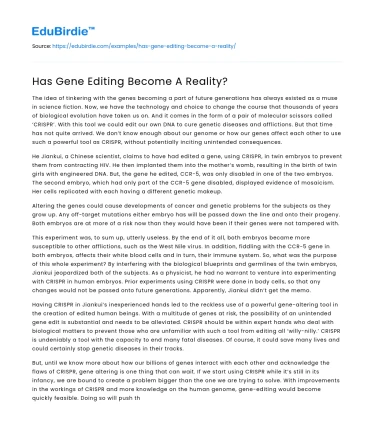The idea of tinkering with the genes becoming a part of future generations has always existed as a muse in science fiction. Now, we have the technology and choice to change the course that thousands of years of biological evolution have taken us on. And it comes in the form of a pair of molecular scissors called ‘CRISPR’. With this tool we could edit our own DNA to cure genetic diseases and afflictions. But that time has not quite arrived. We don’t know enough about our genome or how our genes affect each other to use such a powerful tool as CRISPR, without potentially inciting unintended consequences.
He Jiankui, a Chinese scientist, claims to have had edited a gene, using CRISPR, in twin embryos to prevent them from contracting HIV. He then implanted them into the mother’s womb, resulting in the birth of twin girls with engineered DNA. But, the gene he edited, CCR-5, was only disabled in one of the two embryos. The second embryo, which had only part of the CCR-5 gene disabled, displayed evidence of mosaicism. Her cells replicated with each having a different genetic makeup.
Save your time!
We can take care of your essay
- Proper editing and formatting
- Free revision, title page, and bibliography
- Flexible prices and money-back guarantee
Altering the genes could cause developments of cancer and genetic problems for the subjects as they grow up. Any off-target mutations either embryo has will be passed down the line and onto their progeny. Both embryos are at more of a risk now than they would have been if their genes were not tampered with.
This experiment was, to sum up, utterly useless. By the end of it all, both embryos became more susceptible to other afflictions, such as the West Nile virus. In addition, fiddling with the CCR-5 gene in both embryos, affects their white blood cells and in turn, their immune system. So, what was the purpose of this whole experiment? By interfering with the biological blueprints and germlines of the twin embryos, Jiankui jeopardized both of the subjects. As a physicist, he had no warrant to venture into experimenting with CRISPR in human embryos. Prior experiments using CRISPR were done in body cells, so that any changes would not be passed onto future generations. Apparently, Jiankui didn’t get the memo.
Having CRISPR in Jiankui’s inexperienced hands led to the reckless use of a powerful gene-altering tool in the creation of edited human beings. With a multitude of genes at risk, the possibility of an unintended gene edit is substantial and needs to be alleviated. CRISPR should be within expert hands who deal with biological matters to prevent those who are unfamiliar with such a tool from editing all ‘willy-nilly.’ CRISPR is undeniably a tool with the capacity to end many fatal diseases. Of course, it could save many lives and could certainly stop genetic diseases in their tracks.
But, until we know more about how our billions of genes interact with each other and acknowledge the flaws of CRISPR, gene altering is one thing that can wait. If we start using CRISPR while it’s still in its infancy, we are bound to create a problem bigger than the one we are trying to solve. With improvements in the workings of CRISPR and more knowledge on the human genome, gene-editing would become quickly feasible. Doing so will push the boundaries and open doors to cures rather than catastrophes.
WORKS USED
- Kolata, Gina, and Pam Belluck. “Why Are Scientists So Upset About the First Crispr Babies?” The New York Times. 5 Dec. 2018.
- “He Jiankui defends 'world's first gene-edited babies'.” BBC News. 28 Nov. 2018.






 Stuck on your essay?
Stuck on your essay?

